The world of painting wood surfaces is often dominated by traditional wood paint. Yet, a lesser-known contender has emerged in recent years – masonry paint. This versatile paint, originally reserved for rugged materials like concrete, brick, and stucco, has been quietly intriguing to DIY enthusiasts and professionals alike.
Its adaptability leads us to question: can you use masonry paint on wood? In this exploration, we unravel the feasibility of employing masonry paint on wood, delving into its merits and pitfalls, and offering valuable tips for its effective use.
Whether you are a seasoned DIY enthusiast or a professional painter, prepare to be pleasantly surprised by the possibilities that masonry paint can unveil when adorning your wooden canvases.
PAINTING WOOD WITH MASONRY PAINT:

The conventional path to painting wood typically follows the well-trodden trail of wood-specific paints. A growing trend has emerged, challenging this tradition.
Masonry paint, engineered for rugged exteriors, now beckons the wood. This unexpected union may raise eyebrows, but it comes bearing gifts.
First and foremost, masonry paint is revered for its durability and tenacity in the face of Mother Nature’s fury. It becomes an enticing option for outdoor wood surfaces like garden furniture, fences, or rustic wooden sheds, braving the elements unflinchingly.
What sets masonry paint apart is its vast color palette and texture options. Unlike the limited spectrum of traditional wood paint, masonry paint tantalizes with a multitude of shades and tactile finishes, enabling you to realize your artistic vision, whether you seek sleekness or textured allure.
Before embarking on the journey of applying masonry paint to wood, ponder a few vital considerations. Masonry paint, being thicker and more substantial than its wooden counterpart, may require the wood surface to undergo additional grooming.
Sanding and priming the wood serve as essential preludes, crafting a smoother canvas for the paint to cling to.
It is worth noting that masonry paint doesn’t nestle into wood’s grain the way wood paint does. It prefers to stay on the surface, which could influence the overall aesthetic and endurance of the finish. Hence, the sage advice is to conduct a test run in an inconspicuous nook before committing to the grand transformation.
Painting wood with masonry paint may be a road less traveled, but it offers longevity, a rich color palette, and an opportunity to craft unique finishes. For those who dare to venture, meticulous surface preparation and cautious trials will be your allies in this artistic adventure.
UNDERSTANDING THE PROPERTIES OF MASONRY PAINT:
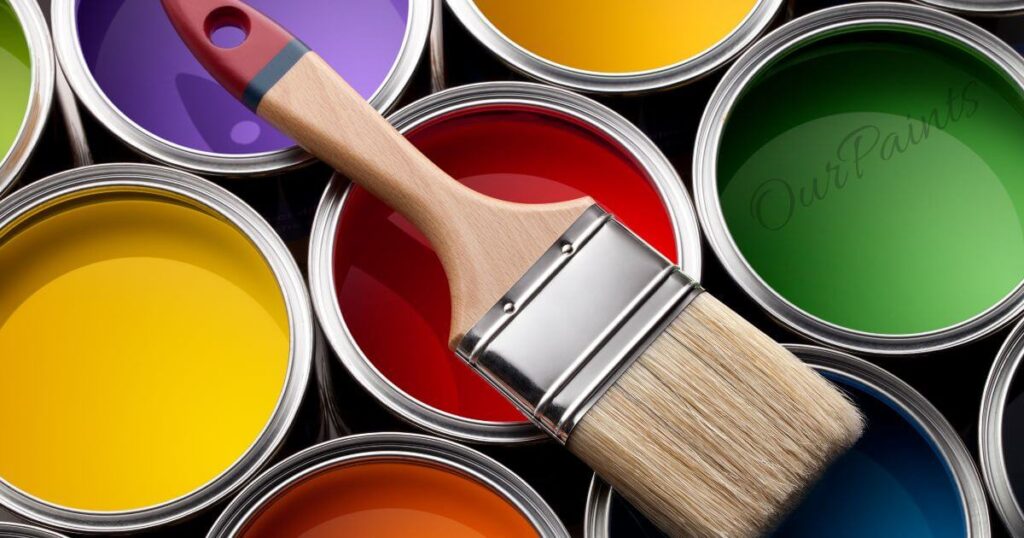
Before embarking on any painting endeavor, it is imperative to decipher the enigmatic properties of the chosen painter. In the case of masonry paint on wood, understanding whether the union is harmonious is key.
Masonry paint, tailor-made for masonry surfaces like concrete, brick, and stucco, is forged in the crucible of endurance. It stands resilient in the face of the harshest elements, resisting moisture penetration, and promising unwavering longevity – qualities that endear it to exterior surfaces.
Wood is a different beast, a porous material that ebbs and flows with temperature and humidity. The wood’s dance can potentially crack or peel the paint unless one crucial property is addressed flexibility.
To find equilibrium, the masonry paint applied to wood must be flexible enough to sway with the wood’s rhythm without forsaking its integrity.
Breathability is another factor to ponder. Wood yearns to breathe, dissipating trapped moisture. Alas, masonry paint, dense and unyielding, can unwittingly imprison this moisture, leading to decay.
The chosen masonry paint must possess breathable properties to preserve the wood’s health and integrity.
The viscosity of masonry paint, thicker than wood paint, ushers in the need for additional preparation. The wood must be tamed to provide a suitable stage for masonry paint. Smoothing the surface or employing a masonry paint-specific primer can ease this transition.
While masonry paint is steadfastly wed to masonry surfaces, its courtship with wood is an intriguing endeavor. Assessing flexibility, breathability, and application nuances will unmask the feasibility of this unique alliance, yielding a long-lasting, harmonious finish.
CAN MASONRY PAINT BE USED ON WOOD SURFACES?
In the realm of wood surface adornment, the default path typically leads to the embrace of wood paint. Yet, there is a tantalizing alternative that beckons, challenging tradition – masonry paint.
Traditionally reserved for hardy surfaces like bricks and concrete, masonry paint boasts durability and weather resistance, qualities that tempt its application on wood.
The answer to the query “Can masonry paint be used on wood?” is a resounding ‘yes,’ but with conditions. The texture of the wood’s surface holds the key.
Masonry paint, designed to cling tenaciously to the rough and porous, may find itself on unfamiliar territory when applied to smooth, non-porous wood.
Successful application hinges on meticulous surface preparation. Cleaning the wood to pristine perfection to eliminate any residual dust, dirt, or earlier paint is your first stride. Sanding follows, imparting a slightly textured terrain for the masonry paint to conquer.
An application of a wood-specific primer adds yet another layer of assurance, enhancing adhesion and paving the way for a smooth conquest.
An inevitable consideration in this union is the finish. Masonry paint’s inherent texture may not align with the desired aesthetic for wood. Some brands offer masonry paints with satin or semi-gloss finishes, delivering a smoother appearance more akin to wood’s grace.
Masonry paint on wood is a possibility, given due attention to surface preparation and an understanding of the wood’s texture. Testing on a discreet patch is sage advice before committing to a full-scale transformation.
If you are inclined to explore a unique path in wood painting, masonry paint might be the unconventional answer to your quest.
PROS AND CONS OF USING MASONRY PAINT ON WOOD:
In the realm of wood painting, the spotlight rarely falls on masonry paint as the chosen medium. Nevertheless, exploring the dichotomy of using masonry paint on wood surfaces reveals a canvas of both promise and challenge.
One of the merits of masonry paint is its formidable durability. Crafted to withstand the unforgiving onslaught of weather, masonry paint stands as a stalwart sentinel against moisture, UV rays, and general wear and tear.
If you are seeking to grace your exterior wooden surfaces – fences, sheds, or garden furniture – with long-lasting protection, masonry paint raises its hand for the job.
Masonry paint is renowned for its ability to cloak imperfections with ease. It can hide blemishes and cracks on wood surfaces, lending a sense of refinement and uniformity. Its thicker consistency, laden with pigment, offers a trustworthy hand in creating a sleek and polished finish on wood.
The dynamic of masonry paint and wood surfaces is not without its caveats. The breathability of wood becomes a cause for concern.
Unlike wood-specific, paints that let wood respire; masonry paint creates a non-breathable barrier, potentially trapping moisture within the wood’s embrace. This entrapment can lead to woes like rot and mold over time.
Masonry paint’s affixation to wood may not be as enduring as that of its wood-specific counterparts. While adept surface preparation and priming can enhance adhesion, masonry paint may not promise the same long-term grip and flexibility found in wood paints.
Utilizing masonry paint on wood comes with the promise of durability and impeccable coverage, but also the peril of limited breathability and potential adhesion hiccups.
Before the definitive brushstroke, it is prudent to seek counsel from professionals and conduct preliminary tests on a discreet section of your wooden canvas to ascertain the suitability of this artistic experiment.
PREPARING THE WOOD SURFACE FOR PAINTING WITH MASONRY PAINT:
Before one dares to immerse wood in the realm of masonry paint, a symphony of preparation must serenade the wood canvas. This prelude is essential to lay the foundation for a seamless and enduring performance.
Step one orchestrates the cleansing of the wood surface. Every speck of dust, dirt, or debris must be ceremoniously evicted. To conduct this cleansing ritual, a gentle concoction of mild detergent and water, accompanied by a soft-bristle brush, takes center stage.
Scrubbing diligently, one must pay homage to nooks and crannies, ensuring all are pristine. The final act consists of rinsing off detergent residues with pristine water and allowing the wood to bask in a sunlit intermission until it dries entirely.
The subsequent act spotlights addressing imperfections or scars that mar the wood’s beauty. Any cracks, holes, or splinters must be acknowledged and repaired. The wood filler emerges as the leading actor in this scene called to duty as per the manufacturer’s script.
The script then directs the smooth application of the filler to any crevice, followed by a softening overture through sanding, rendering the wood’s skin flawless.
To maintain harmony between wood and masonry paint, the wood canvas must undergo a process of light sanding. With fine-grit sandpaper as the instrument of choice, the wood’s surface is gently abraded.
The aim is to eliminate previous coatings, etch a textured path for the masonry paint’s adhesive journey, and offer a pristine canvas.
To ensure this symphony reaches perfection, the act concludes with a dust-clearing interlude, starring a tack cloth or a damp cloth to whisk away any sanding residues. This ensures a pristine canvas awaits the masonry paint’s artistic brushstrokes.
In the finale, a suitable primer emerges as the key player. Primers, uniquely crafted for wood surfaces, contribute to sealing the wood’s integrity and set the stage for impeccable adhesion.
The choice of primer should align with the music of wood and masonry paint. Adherence to the primer’s script is a crucial element for the virtuoso performance of masonry paint on wood.
Through this preparation, the wood canvas is bestowed with the potential for a harmonious and enduring performance, setting the stage for masonry paint to dance across the wood in a display of artistic brilliance.
CHOOSING THE RIGHT TYPE OF MASONRY PAINT FOR WOOD:
Selecting the right masonry paint for wood surfaces is a strategic maneuver to ensure an enduring and harmonious finish.
Although masonry paint is primarily tailored for porous surfaces like concrete and brick, it can indeed be enlisted for wood, given due consideration to the paint’s properties.
Wood’s unique character, less porous and more prone to expansion and contraction, necessitates the choice of masonry paint with care. While masonry paint initially adheres, its longevity on wood depends on the right selection.
Acrylic masonry paint, revered for its flexibility and weather resistance, stands as one potential champion in this endeavor.
Possessing remarkable adhesion properties, this variety creates a sturdy shield on wood surfaces, with resistance to cracking, peeling, and flaking. This makes it a prime choice for exterior wood surfaces, especially those exposed to the elements.
Another contender in the selection process is elastomeric masonry paint. A highly flexible coating, it adapts to the substrate’s movements, effectively bridging small cracks and gaps on the wood’s surface.
This not only enhances protection but also prevents moisture intrusion, making it ideal for wood surfaces exposed to fluctuating temperatures and harsh weather conditions.
Masonry paint’s characteristic density introduces unique considerations. Unlike traditional wood paints, masonry paint is thicker, which can affect the application process. The preparation may need to include smoothing the wood surface or employing a primer specifically designed for masonry paint.
One must also consider the finish, as masonry paint can veer towards a more opaque appearance. If preserving the wood’s natural grain is paramount, this may not be the paint of choice.
In such instances, exploring dedicated wood stains or clear sealants designed for wood surfaces may better suit your artistic vision.
In summation, selecting the right masonry paint for wood surfaces encompasses the quest for suitable protection, aesthetic alignment, and readiness for the wood’s unique conditions.
By making an informed choice and adhering to the proper application techniques, one can expect a magnificent and enduring finish on wood surfaces when embracing masonry paint.
MASTERING THE ART OF APPLYING MASONRY PAINT ON WOOD:
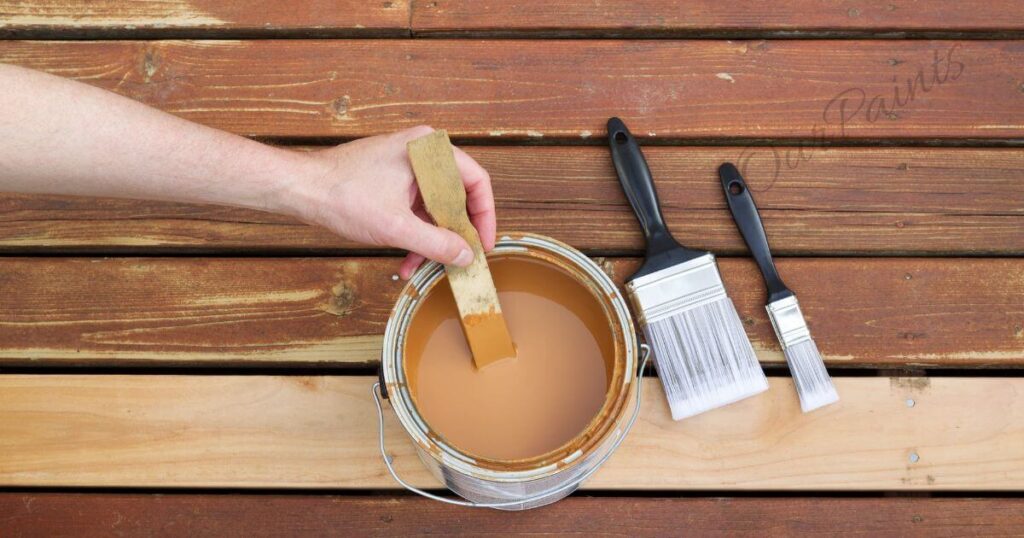
When it comes to the delicate art of painting wood with masonry paint, a mastery of application techniques is essential to achieve a sublime and enduring masterpiece.
Masonry paint, primarily created for formidable surfaces like concrete and brick, can be a challenging partner when summoned to adorn wood. Hence, the conductor must wield the baton with finesse.
The overture to this symphony begins with meticulous surface preparation. The wood, serving as the canvas, must be dressed immaculately. To this end, a deep cleanse to expel dirt, dust, and all remnants of previous coatings is the initial note.
Sanding the wood follows suit, creating a subtly textured terrain for the masonry paint’s embrace. To prepare the wood surface adequately, a suitable primer, tailored for wood, must play a leading role in the overture, enhancing adhesion and bestowing the wood with a smooth and accommodating canvas.
The application of masonry paint, the magnum opus, demands unwavering attention to the maestro’s script – the manufacturer’s instructions. Masonry paint, with its thicker consistency, defies the ordinary brush and roller, demanding the finest instruments.
It is vital to initiate the masterpiece with a thin and even coat, allowing it to perform a solo, drying in solitude before the ensemble’s next performance. This interval ensures that each coat is allowed to shine, unfettered by haste.
The atypical nature of masonry paint on wood may unveil a different aesthetic compared to its original purpose. Texture and finish may vary, and color may appear distinct due to the wood’s unique character.
As the grand performance unfolds, conducting a preliminary act, testing on a small, unassuming section, is advised. Such rehearsals offer valuable insights into the artistry that masonry paint can bestow upon your wooden canvas.
The masterful application of masonry paint on wood involves strict adherence to the overture of surface preparation, a faithful execution of the maestro’s instructions, and an artist’s intuition in understanding the wood’s unique nuances.
This harmonious symphony ensures a timeless and entrancing finish, where wood and masonry paint dance in perfect unison.
TIPS FOR ACHIEVING A SMOOTH AND DURABLE FINISH:
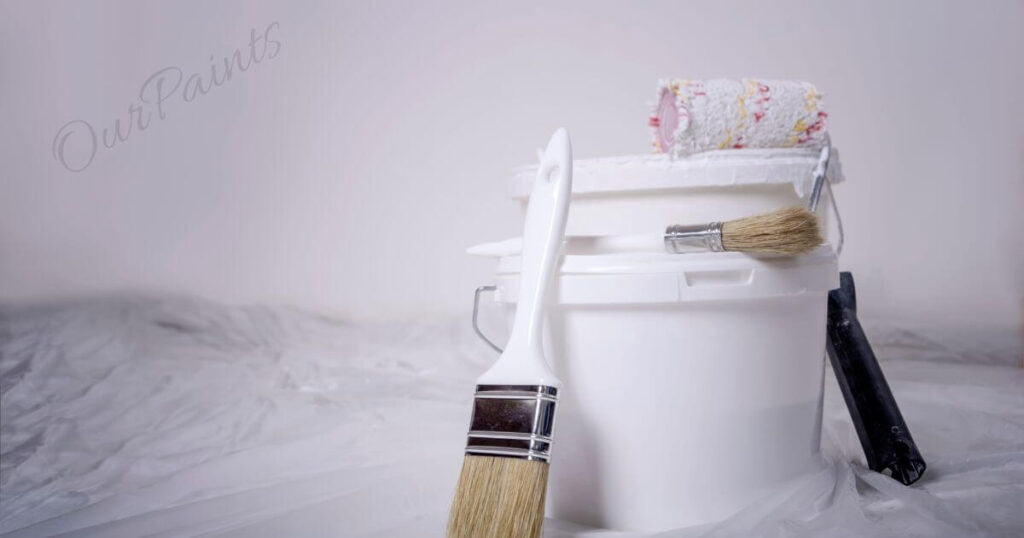
Achieving a smooth and durable finish when painting wood with masonry paint requires careful preparation and application techniques. Here are some valuable tips to help you achieve the best results:
Clean and prepare the wood surface:
Before applying masonry paint, ensure that the wood surface is clean and free from any dirt, dust, or debris. Use a mild detergent and water solution to wash the wood, and then allow it to dry completely. Remove any loose or flaking paint by scraping or sanding the surface.
A smooth and clean surface will ensure better adhesion of the masonry paint.
Prime the wood:
Applying a primer specifically designed for wood surfaces is crucial to achieving a smooth and durable finish. The primer will create a strong bond between the wood and the masonry paint, improving its longevity.
Choose a high-quality wood primer that is compatible with masonry paint and apply it evenly across the entire surface. Allow the primer to dry according to the manufacturer’s instructions.
Choose the right masonry paint:
Not all masonry paints are suitable for wood surfaces. Look for a masonry paint that is specifically formulated for wood applications. These paints typically contain additives that enhance adhesion, flexibility, and durability on wood.
Consider the color and finish you desire before selecting the paint. Be sure to follow the manufacturer’s instructions regarding application and drying times.
Apply multiple thin coats:
Instead of applying one thick coat, it is recommended to apply multiple thin coats of masonry paint. This approach ensures better coverage, minimizes the risk of drips or runs, and allows each coat to dry thoroughly.
Use a high-quality brush or roller to apply the paint evenly in long, smooth strokes, following the wood’s grain. Allow each coat to dry completely before applying the next.
Sand between coats:
To achieve an even smoother finish, lightly sand the surface between each coat of masonry paint. This helps to remove any imperfections or brush marks and creates a smoother surface for subsequent coats.
Use fine-grit sandpaper and gently sand the surface in the direction of the wood grain. After sanding, remove any dust before applying the next coat.
Seal the paint:
Once you have achieved the desired number of coats and a smooth finish, consider applying a clear sealant to protect the paint and enhance its durability. The sealant will provide an additional layer of protection against moisture, UV rays, and general wear and tear.
Choose a sealant specifically formulated for exterior wood applications and follow the manufacturer’s instructions for application and drying times.
By following these tips, you can ensure that your wood surfaces are painted with masonry paint in a way that achieves a smooth and long-lasting finish.
Proper preparation, selection of suitable products, and careful application techniques will help you achieve the best results and keep your wood looking beautiful for years to come.
LONG-TERM DURABILITY OF WOOD PAINTED WITH MASONRY PAINT:
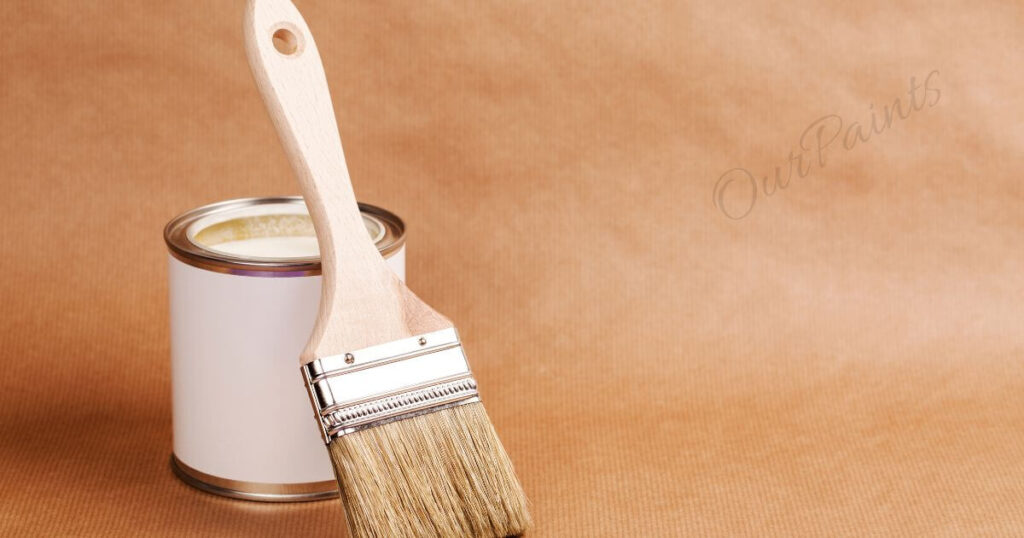
As you embark on the journey of adorning wood with masonry paint, it is vital to peer into the crystal ball of long-term maintenance and the endurance of this artistic endeavor.
While masonry paint is designed to stand tall against the relentless onslaught of weather on surfaces like concrete and brick, wood presents a different canvas with unique demands.
Masonry paint’s initial adherence to wood may promise a harmonious union, but the wood’s natural rhythm of expansion and contraction can challenge this union over time.
The ballet of wood’s natural movement may cause cracks, peels, or chips, casting a shadow on the paint’s longevity.
Wood’s penchant for absorbing moisture can further challenge the paint’s integrity. It is essential to recognize that masonry paint and wood have their unique dynamics and properties.
Instead of the artistic experiment of using masonry paint on wood, a more pragmatic path suggests itself. Choosing paint specifically formulated for wood ensures longevity, better adhesion, and protection against environmental elements.
These paints accommodate wood’s natural movement, form a sturdy bond, and act as guardians against moisture, UV rays, and wear and tear.
Selecting the appropriate paint for wood liberates one from the chore of frequent touch-ups and maintenance.
Consulting with professionals or engaging in a symphony of guidance from paint manufacturers can illuminate the path to a beautiful and long-lasting finish for your wood surfaces.
By considering the grand tapestry of long-term maintenance and durability, you can paint your wood surfaces with a brush that leaves an enduring mark of beauty and resilience. Artistry and practicality converge to ensure a timeless masterpiece.
Exploring Beyond Masonry Paint: Alternative Options for Wood Surfaces:
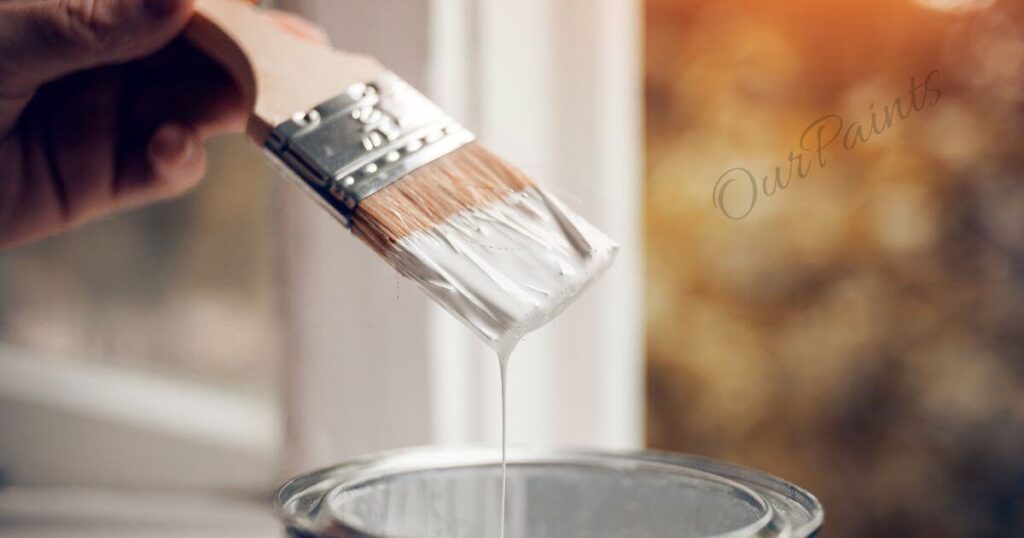
The world of painting wood surfaces is not confined to the customary realms of traditional wood paint. Beyond the familiar, there exists a realm of alternative options, and masonry paint is one intriguing candidate in this artistic ensemble.
Although masonry paint is a seasoned performer on concrete and brick stages, it seeks to step into the spotlight on wood’s grand stage.
Masonry paint, in its embrace of wood, offers a unique blend of strengths. Its reputation for durability is well-earned, as it defies the ravages of harsh weather, holding firm against moisture, UV rays, and the general rigors of outdoor life.
This endows it with the ability to extend the lifespan of a wood surface, making it a noteworthy contender for exterior wood, from fences to sheds.
Another enticing facet of this artistic endeavor is the palette it provides. Masonry paint unveils a spectrum of colors and finishes, a cornucopia of creative possibilities.
Unlike the restrained offering of traditional wood paint, masonry paint allows you to paint your story in bold or subtle shades, craft a matte or glossy finish, and unleash your inner artist.
The overture to this artistic venture requires a modicum of caution. Masonry paint, with its greater density compared to traditional wood paint, necessitates an act of preparation.
Wood’s canvas must be perfected through sanding and priming, creating a harmonious canvas for the masonry paint to showcase its artistry.
Masonry paint may not imbue wood in the same way as dedicated wood paint, potentially affecting the final result. As such, a preliminary test on a concealed portion of the wood surface is a prudent overture before committing to the grand performance.
Masonry paint introduces itself as a new and intriguing character in the realm of painting wood. Its attributes of durability and the vast canvas of colors and textures it unfurls make it a noteworthy consideration for specific wood projects.
As the curtains rise, masonry paint emerges as an unanticipated performer in the artistic ensemble of wood painting.
CONCLUSION:
It is crucial to know that masonry paint is primarily developed for use on masonry and concrete surfaces. Its composition, including its binding agents and pigments, is optimized to cling to these materials and give durability and resistance to weathering and dampness.
One of the primary challenges with applying masonry paint on wood is its inflexibility. Masonry paint is meant to be hard and less receptive to the natural expansion and contraction of the wood due to temperature and humidity changes.
Masonry paint may not offer the intended aesthetic results when applied to wood. The texture, gloss, and color might not be as attractive or ideal for wooden buildings compared to paint products particularly made for wood.
The choice between masonry paint and wood-specific paint should be made with careful evaluation of the unique project, the intended finish, and the long-term performance expectations.
Investing in the correct paint or coating product for wood can not only increase the visual appeal but also maintain and protect the wood, increasing the lifetime of your project and decreasing maintenance costs over time.
FAQs About Can You Use Masonry Paint On Wood?
Can I use masonry paint on wood for outdoor projects?
Masonry paint is not recommended for wood used outdoors. It may not provide adequate protection against moisture and weathering, leading to premature peeling and deterioration. It’s advisable to use paints or stains specifically designed for wood when working on outdoor wooden surfaces.
Is it ever acceptable to use masonry paint on wood?
While it’s generally not recommended, some homeowners may choose to use masonry paint on interior wood surfaces in low-impact areas. To understand that masonry paint is not optimized for wood, and its durability and finish may not be ideal for wood applications.
Can I prime wood before applying masonry paint to improve adhesion?
Priming wood before using masonry paint may help with adhesion to some extent, but it doesn’t address the fundamental issues associated with using the wrong type of paint on wood. Even with primer, masonry paint is still less flexible and may not perform well on wooden surfaces over time.
What are the risks of using masonry paint on wood?
Using masonry paint on wood surfaces can result in issues such as cracking, peeling, flaking, and poor long-term adhesion. Masonry paint may not offer the same level of protection against moisture, UV rays, and wood-specific environmental factors.
What paint should I use for wood instead of masonry paint?
To ensure the best results for wood surfaces, it’s recommended to use paints, stains, or sealers specifically formulated for wood. These products are designed to accommodate the natural expansion and contraction of wood, provide durability, and offer superior protection against environmental elements, making them the preferred choice for wood-based projects.

